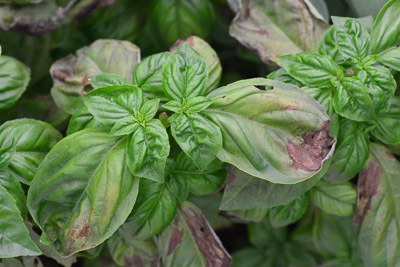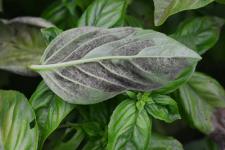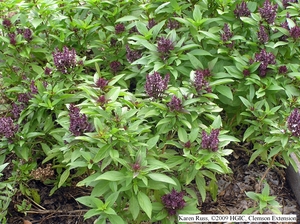Basil Downy Mildew
By Gil Medeiros, Fairfax Master Gardener
updated October 2018

Symptoms and signs of basil downy mildew
Basil downy mildew lives year round in Florida and in greenhouses where basil is cultivated. It does not survive the winter in our area. Its spores can travel long distances on air currents. Plants and growing media infected in a greenhouse are likely to show the disease whenever the temperature and humidity reach optimum levels for P. behlbarii to grow. The pathogen is thought to travel on infected seed, but this mechanism is not well understood.

Gray fuzz on the underside of a leaf
What’s a basil-loving gardener to do? It should come as no surprise that there were no fungicide sprays approved for use on sweet basil at the time basil downy mildew first appeared. There had been no problem so there was no need to devise a solution. When it became critical to address the problem, it proved to be a difficult task. Peranospora behlbarii isn’t just any old fungus. It is an oomycete. Oomycetes are fungus-like organisms that laugh (or wave their tiny tails) at standard garden fungicides.
Experienced gardeners quake when they hear the word oomycetes. It includes a rogue’s gallery of plant pathogens such as Phytophthera infestans (late blight of tomatoes and potatoes), Plasmopara viticola (downy mildew of grapes) and Pythium spp. (damping off of seedlings and various root rots). The literature now cites some chemical treatments for basil downy mildew. Potassium bicarbonate and neem oil are OMRI-approved organic treatments. Like most fungicides for home use, they must be used as preventative sprays, applied before the disease appears, but their effectiveness is limited. It is important to note that the Virginia Pest Management Guide for 2016 does not yet list basil downy mildew nor recommend any specific treatments for the disease.
Research is ongoing to find a silver bullet-type treatment. Among the promising candidates are mefenoxam and azoxystrobin, potent systemic fungicides which must be used weeks ahead of harvest time to mitigate the poisonous effects of the chemicals. Such products are likely to be useful for greenhouse producers, not home gardeners. But think about it. Do you really want to eat leaves that have been sprayed with a potent fungicide? Do you relish eating pesto spiked with mefenoxam, or marinara sauce containing azoxystrobin? I am not above using chemicals occasionally, but this is not appetizing to me.
Depending on your tastes, there may be other palatable options. Ocimum basilicum ‘Siam Queen,’ an All America selection in 1997, is highly resistant to basil downy mildew. Ocimum americanum ‘Blue Spice’ is virtually immune to the disease. Both smell great; the scent resembles licorice. I have grown both of them successfully in both garden beds and containers. The only problem is that my spouse doesn’t like the taste of either so we have no culinary use for these basils.

Basil ‘Siam Queen’
So is Sweet Basil doomed to fail in our gardens? Not necessarily. Remember the basil grown in the pot on my deck was not affected by the disease. Why not? Most likely the air circulation on my elevated deck is better than in my vegetable garden. Good air circulation is one of the cultural methods that helps prevent fungus and fungus-like infections. Also, back in 2013 I still did overhead watering in my vegetable garden; I have since discontinued that practice. The basil plant in the pot received watering directly on the potting medium, not on the foliage.
I have grown basil in containers successfully ever since.
So there you have it. There is a cultural formula for success.
- Minimize overhead watering that wets the foliage.
- Maximize air circulation and drying by choosing a spot in full sun where you can feel the breezes.
- Maintain a distance of three feet or more between plants, again to promote air circulation.
- Planting basil in containers probably helps produce the conditions described above.
- If you find the symptoms of basil downy mildew on any of your plants, send the plant to the trash immediately.
You can also try a basil with resistance to the disease. Who knows? You might like the taste.
References
Basil Downy Mildew, University of Minnesota Extension
Basil Downy Mildew, University of Massachusetts Amherst Extension
Downy Mildew on Basil, University of Maryland Extension
Rutgers Obsession, Devotion, and Thunderstruck Basil, Rutgers University, School of Environmental and Biological Sciences